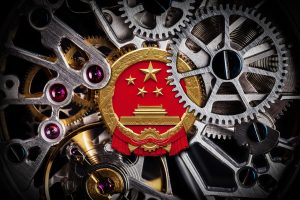Contrary to a common belief held by many, communist parties have an obsession with institutions. There is a reason why “organization” is often used as a comprehensive and all-purposeful reference. It almost seems to be a term of endearment referring to the omnipresent and omnipotent collective entity of the Communist Party whenever its identity is too complicated or inconvenient to dissect and specify. In the television series “The Americans,” a popular Hollywood spy drama set in the Cold War era, the word “organization” pops up in casual conversations between the protagonists as if it was the nickname for a common acquaintance.
Half a century later in China, the word “organization” (组织 in Chinese) still commands loyalty, honesty, and reverence – so much so that any behavior contrary to those noble values would invite disciplinary reproaches. In the Directive of the Disciplines and Sanctions of the Chinese Communist Party (2018), the word “organization” appeared 120 times. Fifteen types of inappropriate behavior are identified as “violations of organizational discipline,” which can lead to “excommunication,” as it were, the most serious form of disciplinary sanctions that often triggers prosecution.
The appreciation of party institutions as a source of strength and a tool for power-seeking is not an invention of the Chinese Communist Party (CCP). Chinese imperial rulers had championed institution-building, already running a mature bureaucracy, a complicated form of institution, during the reign of the Western Zhou Dynasty more than 3,000 years ago. However, to weaponize institutions as a combative strategy rather than merely an administrative instrument stems from a Leninist communist legacy.
“In its struggle for power, the proletariat has no other weapon except organization,” Lenin wrote in 1904. Philip Selznick, the late Berkeley professor of sociology and law who coined the term “organizational weapon” defines it as an instrument that “can be used by a power-seeking elite in a manner unrestrained by the constitutional order of the arena within which the contest takes place.” Bolsheviks used it with decisiveness and skills to subvert an established political order and to replace it with their own. The Chinese Communist Party followed suit and achieved more.
Once the Communist Party obtained power, the organization had to be repurposed for the opposite aim of its weaponized deployment. As the single ruling political force, the party has no other political establishment to subvert in the homeland. Its political operation not only is no longer illegal but is protected by self-enacted laws. The state system, which used to be so alien and antagonistic that it had to be infiltrated and sometimes smashed, now has its doors wide open and is ready to service the Communist Party, to sustain its life and to fuel its growth.
In this “emancipated” world of the party-state, it is only natural that institutions, especially formal institutions, have become an indispensable instrument of political governance to regulate not only state-society relations but also elite politics, such as the issue of leadership succession.
In the run-up to the 20th National Party Congress, there has been no shortage of international commentary on what to expect. But, regrettably, the operation of the Congress itself, one of the oldest institutions of the CCP, has been overlooked in relevant discussions. What is the National Party Congress, what happens there, and who ultimately makes the decisions?

































